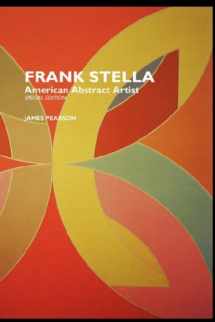
Frank Stella: American Abstract Artist
ISBN-13:
9781861710734
ISBN-10:
1861710739
Edition:
3rd
Author:
James Pearson
Publication date:
2007
Publisher:
Crescent Moon Pub
Format:
Paperback
128 pages
FREE US shipping
Book details
ISBN-13:
9781861710734
ISBN-10:
1861710739
Edition:
3rd
Author:
James Pearson
Publication date:
2007
Publisher:
Crescent Moon Pub
Format:
Paperback
128 pages
Summary
Frank Stella: American Abstract Artist (ISBN-13: 9781861710734 and ISBN-10: 1861710739), written by authors
James Pearson, was published by Crescent Moon Pub in 2007.
With an overall rating of 3.8 stars, it's a notable title among other
books. You can easily purchase or rent Frank Stella: American Abstract Artist (Paperback) from BooksRun,
along with many other new and used
books
and textbooks.
And, if you're looking to sell your copy, our current buyback offer is $0.3.
Description
FRANK STELLA A study of the American abstract artist Frank Stella (b. 1936), surveying his career from the famous Black Paintings of the late 1950s up to the present. Stella has become become among America’s premier contemporary artists. Unlike many 20th century artists, Stella has always worked in abstraction. His art is irrepressible, daring, hugely enjoyable, and refreshingly angst-free. This book begins with the celebrated Black Paintings of 1959, moves on through the Minimalist Copper and Aluminium paintings of the early Sixties, to the exuberant Protractor series, the expansion into three dimensions in the 1970s, and closing with the 3-dimensional Polish Village, Exotic Birds and Brazilian ‘maximalist’ works of the 1980s and 1990s. Employing the most up-to-date art criticism of Frank Stella, James Pearson also looks at Stella’s contemporaries: Jasper Johns, Robert Rauschenberg, Kenneth Noland, Jules Olitski, Morris Louis, Robert Ryman, Brice Marden, Mark Rothko and Barnett Newman among others. ? ? EXTRACT FROM CHAPTER 5 There does not seem to be much going on in some of Frank Stella’s 1960s Minimal paintings. But there is, in fact, a lot going on. Stella limits himself to a narrow set of rules. Like Brice Marden, Barnett Newman, Morris Louis and Mark Rothko, Stella sets himself to explore a few configurations of painting. But these things – the shape of the canvas, internal organization of the stripes, colour of the bands – offer up endless permutations. Frank Stella’s paintings are lean, but leanness does not necessarily mean unfeelingness. This is the problem that monochrome painting creates, and Minimal art in general. Certainly Stella is intense: his Black Stripe Paintings, his Protractor series, his copper paintings, his India Birds, are intense works of art. The Stella exhibitions of the late 1980s and early 1990s were affairs, in which one was impressed by a sense of colour and light, a spaciousness to the works, and a huge scale, so that each work dominated the gallery rooms. Stella is in no way a quiet, unobtrusive artist: his paintings are domineering, self-confident, assured of their own effects. Stella has always been an artist who knows what he’s doing. His paintings do not lurk in gallery corners, shyly. His paintings announce themselves instantly and powerfully. Stella’s June-July 1985 show at the ICA in London was typical: massive multi-media works were squeezed into the ubiquitous sparse white rooms, completely taking over the sedate spaces.


We would LOVE it if you could help us and other readers by reviewing the book
Book review

Congratulations! We have received your book review.
{user}
{createdAt}
by {truncated_author}


